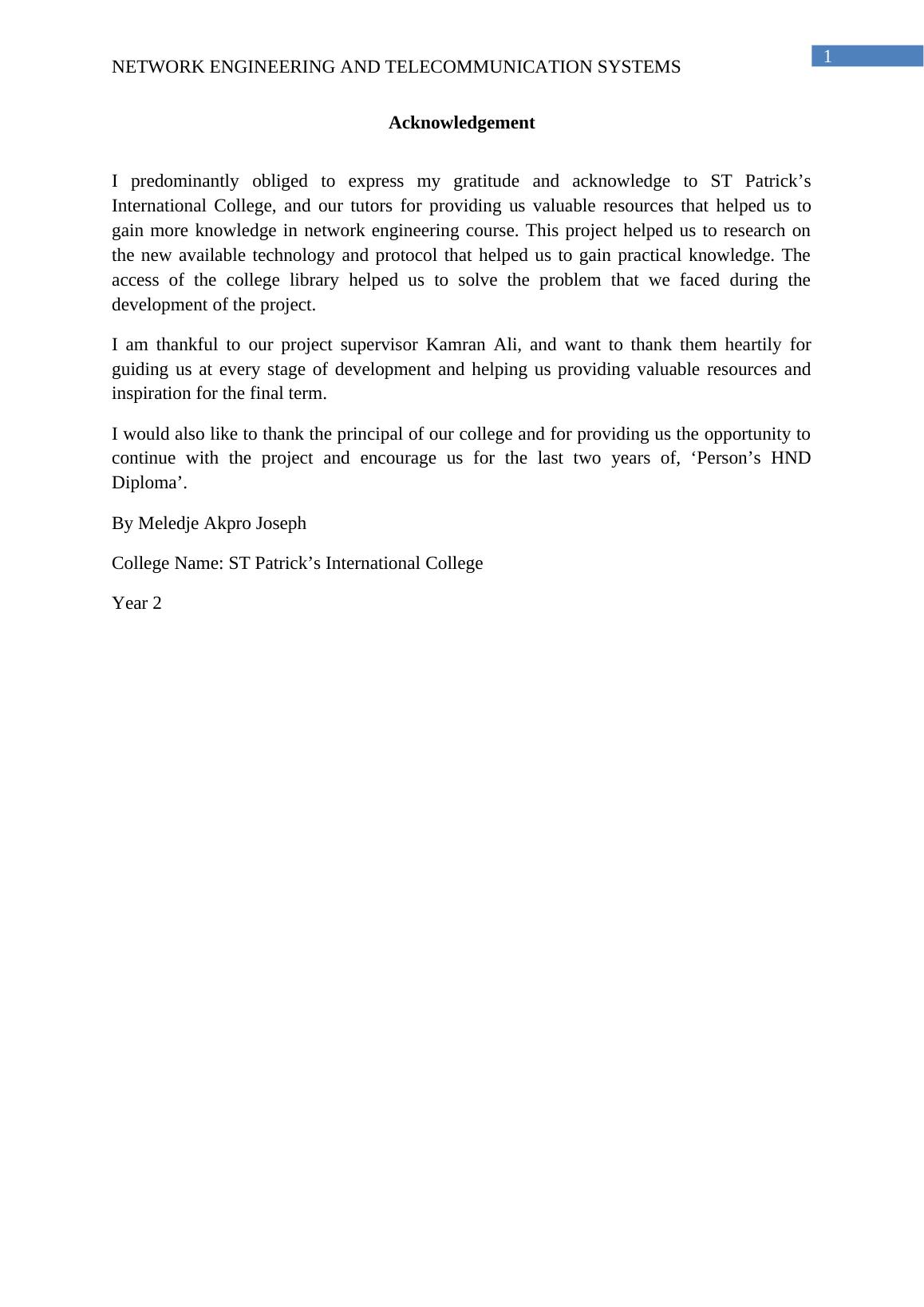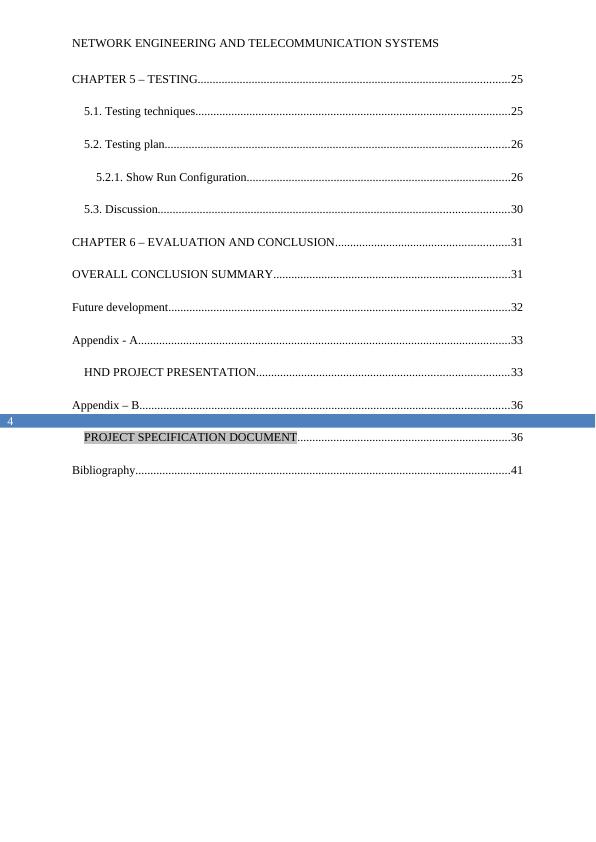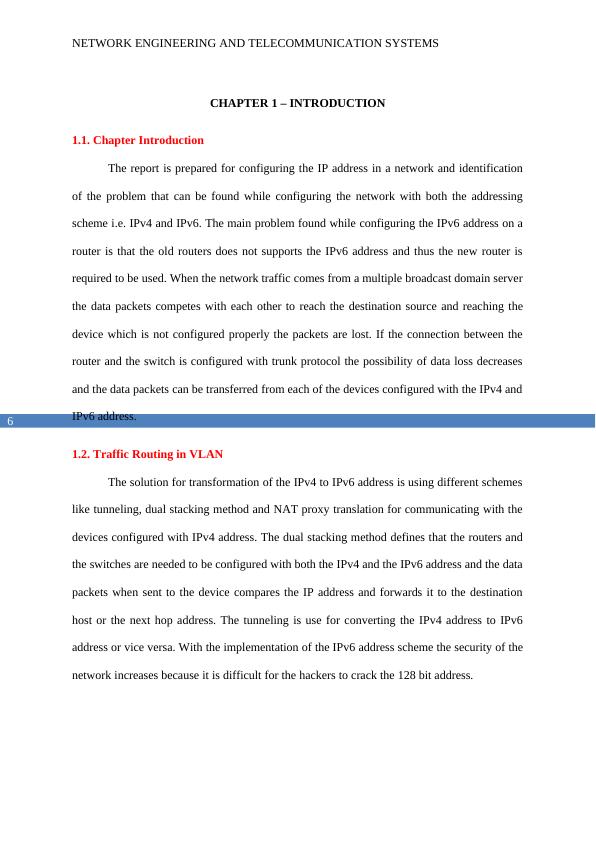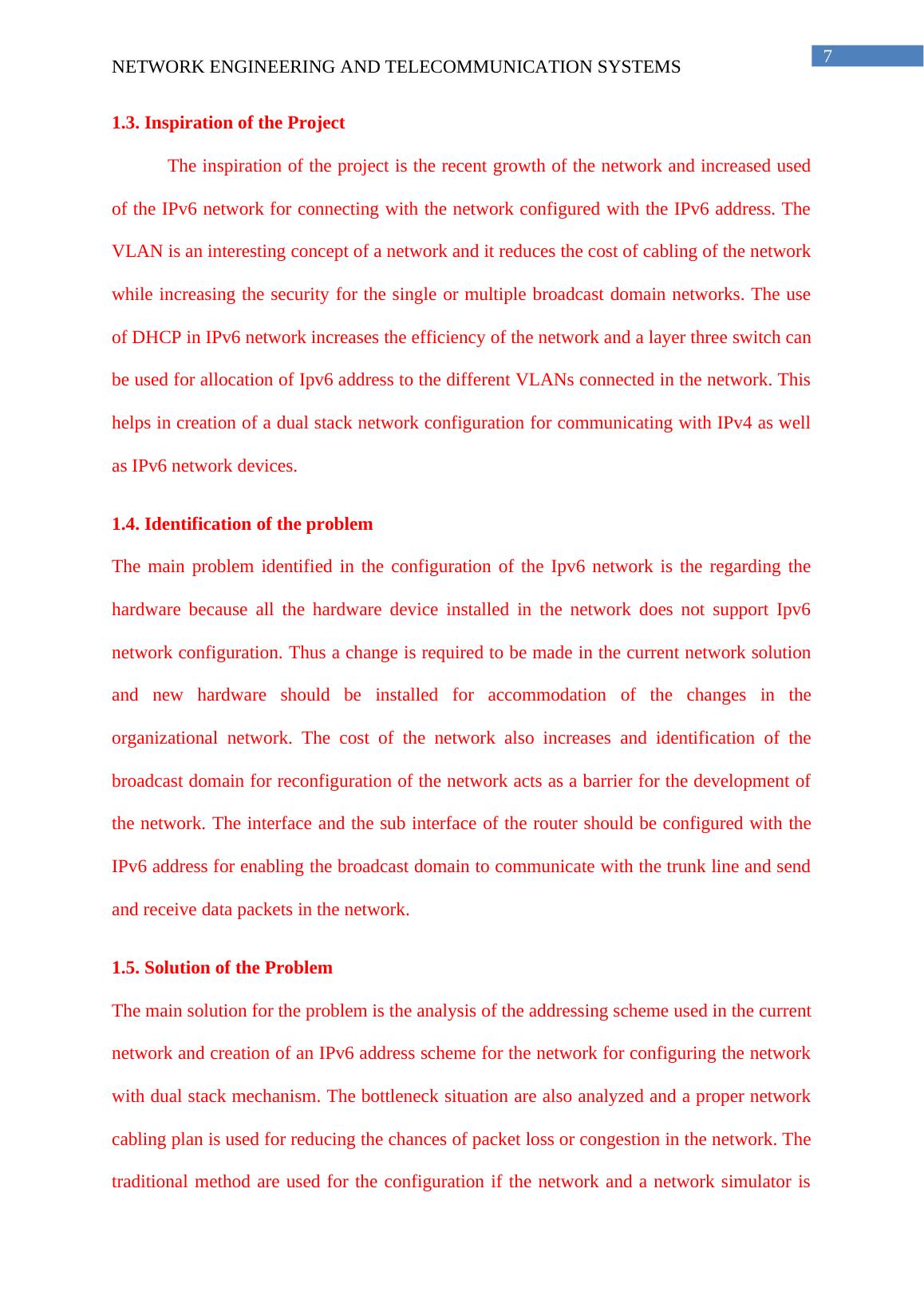NETWORK ENGINEERING AND TELECOMMUNICATION SYSTEMS Migrating From IPv4 to IPv6 Name of the University ST Patrick's International College Author's Note Acknowledgement
Added on 2020-04-07
44 Pages7216 Words67 Views
NETWORK ENGINEERING AND TELECOMMUNICATION SYSTEMS
Migrating From IPv4 to IPv6
Name of the Student
Meledje Akpro Joseph
Name of the University
ST PATRICK’S INTERNATIONAL COLLEGE
Author’s Note
Migrating From IPv4 to IPv6
Name of the Student
Meledje Akpro Joseph
Name of the University
ST PATRICK’S INTERNATIONAL COLLEGE
Author’s Note

1
NETWORK ENGINEERING AND TELECOMMUNICATION SYSTEMS
Acknowledgement
I predominantly obliged to express my gratitude and acknowledge to ST Patrick’s
International College, and our tutors for providing us valuable resources that helped us to
gain more knowledge in network engineering course. This project helped us to research on
the new available technology and protocol that helped us to gain practical knowledge. The
access of the college library helped us to solve the problem that we faced during the
development of the project.
I am thankful to our project supervisor Kamran Ali, and want to thank them heartily for
guiding us at every stage of development and helping us providing valuable resources and
inspiration for the final term.
I would also like to thank the principal of our college and for providing us the opportunity to
continue with the project and encourage us for the last two years of, ‘Person’s HND
Diploma’.
By Meledje Akpro Joseph
College Name: ST Patrick’s International College
Year 2
NETWORK ENGINEERING AND TELECOMMUNICATION SYSTEMS
Acknowledgement
I predominantly obliged to express my gratitude and acknowledge to ST Patrick’s
International College, and our tutors for providing us valuable resources that helped us to
gain more knowledge in network engineering course. This project helped us to research on
the new available technology and protocol that helped us to gain practical knowledge. The
access of the college library helped us to solve the problem that we faced during the
development of the project.
I am thankful to our project supervisor Kamran Ali, and want to thank them heartily for
guiding us at every stage of development and helping us providing valuable resources and
inspiration for the final term.
I would also like to thank the principal of our college and for providing us the opportunity to
continue with the project and encourage us for the last two years of, ‘Person’s HND
Diploma’.
By Meledje Akpro Joseph
College Name: ST Patrick’s International College
Year 2

2
NETWORK ENGINEERING AND TELECOMMUNICATION SYSTEMS
Table of Contents
CHAPTER 1 – INTRODUCTION............................................................................................6
1.1. Chapter Introduction.......................................................................................................6
1.2. Traffic Routing in VLAN................................................................................................6
1.3. Inspiration of the Project.................................................................................................6
1.4. Identification of the problem...........................................................................................7
1.5. Solution of the Problem..................................................................................................7
1.6. Aims................................................................................................................................8
1.7. Objectives........................................................................................................................8
1.8. Records of risk, constraints and assumptions.................................................................9
1.9. Project Plan and deliverables........................................................................................10
1.10. Report Layout..............................................................................................................10
1.11. Summary.....................................................................................................................11
CHAPTER 2 – LITERATURE REVIEW...............................................................................12
2.6. Problems of the current system.....................................................................................12
2.7. Equipment’s required for the transition from IPv4 to IPv6..........................................13
2.8. Technology analyzed from the review..........................................................................13
2.8.1. Inter vlan routing....................................................................................................13
2.8.2. VLAN Pruning.......................................................................................................14
2.8.3. Concept of spanning tree protocol.........................................................................14
2.8.4. Limitation of the spanning tree protocol................................................................15
NETWORK ENGINEERING AND TELECOMMUNICATION SYSTEMS
Table of Contents
CHAPTER 1 – INTRODUCTION............................................................................................6
1.1. Chapter Introduction.......................................................................................................6
1.2. Traffic Routing in VLAN................................................................................................6
1.3. Inspiration of the Project.................................................................................................6
1.4. Identification of the problem...........................................................................................7
1.5. Solution of the Problem..................................................................................................7
1.6. Aims................................................................................................................................8
1.7. Objectives........................................................................................................................8
1.8. Records of risk, constraints and assumptions.................................................................9
1.9. Project Plan and deliverables........................................................................................10
1.10. Report Layout..............................................................................................................10
1.11. Summary.....................................................................................................................11
CHAPTER 2 – LITERATURE REVIEW...............................................................................12
2.6. Problems of the current system.....................................................................................12
2.7. Equipment’s required for the transition from IPv4 to IPv6..........................................13
2.8. Technology analyzed from the review..........................................................................13
2.8.1. Inter vlan routing....................................................................................................13
2.8.2. VLAN Pruning.......................................................................................................14
2.8.3. Concept of spanning tree protocol.........................................................................14
2.8.4. Limitation of the spanning tree protocol................................................................15

3
NETWORK ENGINEERING AND TELECOMMUNICATION SYSTEMS
2.9. Drawback of the current proposed solution..................................................................15
2.9.1. Solution..................................................................................................................15
2.10. Benefits of the network...............................................................................................15
2.11. Development tools and review techniques..................................................................16
2.11.1. Network Designing software................................................................................16
2.11.2. Simulation software.............................................................................................17
2.11.4. Summary..............................................................................................................18
CHAPTER 3 – ANALYSIS AND DESIGN...........................................................................19
3.1. Chapter introduction......................................................................................................19
3.2. Discussion of the analysis.............................................................................................19
3.3. Discussion of the design................................................................................................19
3.4. Development Methodology...........................................................................................20
CHAPTER 4 – IMPLEMENTATION.....................................................................................20
4.1. Introduction...................................................................................................................20
4.2. Implementation.............................................................................................................21
4.2.1. Challenges faced during the implementation.........................................................21
4.2.2. Solution of the problem..........................................................................................21
4.2.3. Layer 3 switch configuration.................................................................................22
4.3. Demonstration of the Artifacts......................................................................................24
4.3.1. Auto Ipv6 configuration.........................................................................................24
4.4. Summary.......................................................................................................................25
NETWORK ENGINEERING AND TELECOMMUNICATION SYSTEMS
2.9. Drawback of the current proposed solution..................................................................15
2.9.1. Solution..................................................................................................................15
2.10. Benefits of the network...............................................................................................15
2.11. Development tools and review techniques..................................................................16
2.11.1. Network Designing software................................................................................16
2.11.2. Simulation software.............................................................................................17
2.11.4. Summary..............................................................................................................18
CHAPTER 3 – ANALYSIS AND DESIGN...........................................................................19
3.1. Chapter introduction......................................................................................................19
3.2. Discussion of the analysis.............................................................................................19
3.3. Discussion of the design................................................................................................19
3.4. Development Methodology...........................................................................................20
CHAPTER 4 – IMPLEMENTATION.....................................................................................20
4.1. Introduction...................................................................................................................20
4.2. Implementation.............................................................................................................21
4.2.1. Challenges faced during the implementation.........................................................21
4.2.2. Solution of the problem..........................................................................................21
4.2.3. Layer 3 switch configuration.................................................................................22
4.3. Demonstration of the Artifacts......................................................................................24
4.3.1. Auto Ipv6 configuration.........................................................................................24
4.4. Summary.......................................................................................................................25

4
NETWORK ENGINEERING AND TELECOMMUNICATION SYSTEMS
CHAPTER 5 – TESTING........................................................................................................25
5.1. Testing techniques.........................................................................................................25
5.2. Testing plan...................................................................................................................26
5.2.1. Show Run Configuration........................................................................................26
5.3. Discussion.....................................................................................................................30
CHAPTER 6 – EVALUATION AND CONCLUSION..........................................................31
OVERALL CONCLUSION SUMMARY...............................................................................31
Future development..................................................................................................................32
Appendix - A............................................................................................................................33
HND PROJECT PRESENTATION....................................................................................33
Appendix – B...........................................................................................................................36
PROJECT SPECIFICATION DOCUMENT.......................................................................36
Bibliography.............................................................................................................................41
NETWORK ENGINEERING AND TELECOMMUNICATION SYSTEMS
CHAPTER 5 – TESTING........................................................................................................25
5.1. Testing techniques.........................................................................................................25
5.2. Testing plan...................................................................................................................26
5.2.1. Show Run Configuration........................................................................................26
5.3. Discussion.....................................................................................................................30
CHAPTER 6 – EVALUATION AND CONCLUSION..........................................................31
OVERALL CONCLUSION SUMMARY...............................................................................31
Future development..................................................................................................................32
Appendix - A............................................................................................................................33
HND PROJECT PRESENTATION....................................................................................33
Appendix – B...........................................................................................................................36
PROJECT SPECIFICATION DOCUMENT.......................................................................36
Bibliography.............................................................................................................................41


6
NETWORK ENGINEERING AND TELECOMMUNICATION SYSTEMS
CHAPTER 1 – INTRODUCTION
1.1. Chapter Introduction
The report is prepared for configuring the IP address in a network and identification
of the problem that can be found while configuring the network with both the addressing
scheme i.e. IPv4 and IPv6. The main problem found while configuring the IPv6 address on a
router is that the old routers does not supports the IPv6 address and thus the new router is
required to be used. When the network traffic comes from a multiple broadcast domain server
the data packets competes with each other to reach the destination source and reaching the
device which is not configured properly the packets are lost. If the connection between the
router and the switch is configured with trunk protocol the possibility of data loss decreases
and the data packets can be transferred from each of the devices configured with the IPv4 and
IPv6 address.
1.2. Traffic Routing in VLAN
The solution for transformation of the IPv4 to IPv6 address is using different schemes
like tunneling, dual stacking method and NAT proxy translation for communicating with the
devices configured with IPv4 address. The dual stacking method defines that the routers and
the switches are needed to be configured with both the IPv4 and the IPv6 address and the data
packets when sent to the device compares the IP address and forwards it to the destination
host or the next hop address. The tunneling is use for converting the IPv4 address to IPv6
address or vice versa. With the implementation of the IPv6 address scheme the security of the
network increases because it is difficult for the hackers to crack the 128 bit address.
NETWORK ENGINEERING AND TELECOMMUNICATION SYSTEMS
CHAPTER 1 – INTRODUCTION
1.1. Chapter Introduction
The report is prepared for configuring the IP address in a network and identification
of the problem that can be found while configuring the network with both the addressing
scheme i.e. IPv4 and IPv6. The main problem found while configuring the IPv6 address on a
router is that the old routers does not supports the IPv6 address and thus the new router is
required to be used. When the network traffic comes from a multiple broadcast domain server
the data packets competes with each other to reach the destination source and reaching the
device which is not configured properly the packets are lost. If the connection between the
router and the switch is configured with trunk protocol the possibility of data loss decreases
and the data packets can be transferred from each of the devices configured with the IPv4 and
IPv6 address.
1.2. Traffic Routing in VLAN
The solution for transformation of the IPv4 to IPv6 address is using different schemes
like tunneling, dual stacking method and NAT proxy translation for communicating with the
devices configured with IPv4 address. The dual stacking method defines that the routers and
the switches are needed to be configured with both the IPv4 and the IPv6 address and the data
packets when sent to the device compares the IP address and forwards it to the destination
host or the next hop address. The tunneling is use for converting the IPv4 address to IPv6
address or vice versa. With the implementation of the IPv6 address scheme the security of the
network increases because it is difficult for the hackers to crack the 128 bit address.

7
NETWORK ENGINEERING AND TELECOMMUNICATION SYSTEMS
1.3. Inspiration of the Project
The inspiration of the project is the recent growth of the network and increased used
of the IPv6 network for connecting with the network configured with the IPv6 address. The
VLAN is an interesting concept of a network and it reduces the cost of cabling of the network
while increasing the security for the single or multiple broadcast domain networks. The use
of DHCP in IPv6 network increases the efficiency of the network and a layer three switch can
be used for allocation of Ipv6 address to the different VLANs connected in the network. This
helps in creation of a dual stack network configuration for communicating with IPv4 as well
as IPv6 network devices.
1.4. Identification of the problem
The main problem identified in the configuration of the Ipv6 network is the regarding the
hardware because all the hardware device installed in the network does not support Ipv6
network configuration. Thus a change is required to be made in the current network solution
and new hardware should be installed for accommodation of the changes in the
organizational network. The cost of the network also increases and identification of the
broadcast domain for reconfiguration of the network acts as a barrier for the development of
the network. The interface and the sub interface of the router should be configured with the
IPv6 address for enabling the broadcast domain to communicate with the trunk line and send
and receive data packets in the network.
1.5. Solution of the Problem
The main solution for the problem is the analysis of the addressing scheme used in the current
network and creation of an IPv6 address scheme for the network for configuring the network
with dual stack mechanism. The bottleneck situation are also analyzed and a proper network
cabling plan is used for reducing the chances of packet loss or congestion in the network. The
traditional method are used for the configuration if the network and a network simulator is
NETWORK ENGINEERING AND TELECOMMUNICATION SYSTEMS
1.3. Inspiration of the Project
The inspiration of the project is the recent growth of the network and increased used
of the IPv6 network for connecting with the network configured with the IPv6 address. The
VLAN is an interesting concept of a network and it reduces the cost of cabling of the network
while increasing the security for the single or multiple broadcast domain networks. The use
of DHCP in IPv6 network increases the efficiency of the network and a layer three switch can
be used for allocation of Ipv6 address to the different VLANs connected in the network. This
helps in creation of a dual stack network configuration for communicating with IPv4 as well
as IPv6 network devices.
1.4. Identification of the problem
The main problem identified in the configuration of the Ipv6 network is the regarding the
hardware because all the hardware device installed in the network does not support Ipv6
network configuration. Thus a change is required to be made in the current network solution
and new hardware should be installed for accommodation of the changes in the
organizational network. The cost of the network also increases and identification of the
broadcast domain for reconfiguration of the network acts as a barrier for the development of
the network. The interface and the sub interface of the router should be configured with the
IPv6 address for enabling the broadcast domain to communicate with the trunk line and send
and receive data packets in the network.
1.5. Solution of the Problem
The main solution for the problem is the analysis of the addressing scheme used in the current
network and creation of an IPv6 address scheme for the network for configuring the network
with dual stack mechanism. The bottleneck situation are also analyzed and a proper network
cabling plan is used for reducing the chances of packet loss or congestion in the network. The
traditional method are used for the configuration if the network and a network simulator is

End of preview
Want to access all the pages? Upload your documents or become a member.
Related Documents
Project on the New Available Technologylg...
|44
|7377
|65
Proposal of a WAN Solution for the School Campus of Singapore Gaming Academylg...
|25
|4952
|250
An Empirical Study of VPN Options for Resource-Constrained IoT Deviceslg...
|25
|6293
|1
Design and Test of Solar Thermal Collector with Coil Geometrieslg...
|71
|10280
|148
Dissertation Assignment 2022lg...
|45
|13164
|39
Department of Engineering and Computing - Smart Homelg...
|63
|11563
|11
